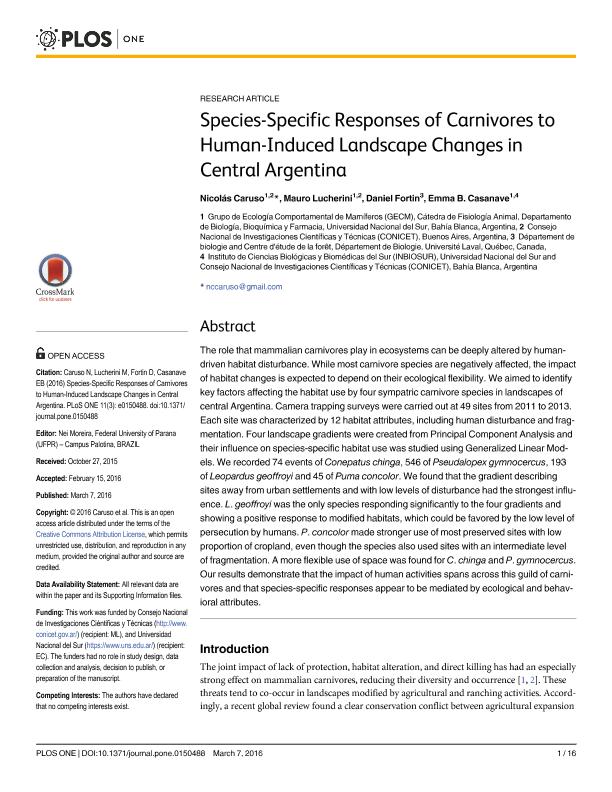Mostrar el registro sencillo del ítem
dc.contributor.author
Caruso, Nicolás

dc.contributor.author
Lucherini, Mauro

dc.contributor.author
Fortin D.
dc.contributor.author
Casanave, Emma Beatriz

dc.date.available
2018-04-03T18:53:18Z
dc.date.issued
2016-03
dc.identifier.citation
Caruso, Nicolás; Lucherini, Mauro; Fortin D.; Casanave, Emma Beatriz; Species-specific responses of carnivores to human-induced landscape changes in central Argentina; Public Library of Science; Plos One; 11; 3; 3-2016; 1-16; e0150488
dc.identifier.issn
1932-6203
dc.identifier.uri
http://hdl.handle.net/11336/40546
dc.description.abstract
The role that mammalian carnivores play in ecosystems can be deeply altered by human-driven habitat disturbance. While most carnivore species are negatively affected, the impact of habitat changes is expected to depend on their ecological flexibility. We aimed to identify key factors affecting the habitat use by four sympatric carnivore species in landscapes of central Argentina. Camera trapping surveys were carried out at 49 sites from 2011 to 2013. Each site was characterized by 12 habitat attributes, including human disturbance and fragmentation. Four landscape gradients were created from Principal Component Analysis and their influence on species-specific habitat use was studied using Generalized Linear Models. We recorded 74 events of Conepatus chinga, 546 of Pseudalopex gymnocercus, 193 of Leopardus geoffroyi and 45 of Puma concolor.We found that the gradient describing sites away from urban settlements and with low levels of disturbance had the strongest influence. L. geoffroyi was the only species responding significantly to the four gradients and showing a positive response to modified habitats, which could be favored by the low level of persecution by humans. P. concolor made stronger use of most preserved sites with low proportion of cropland, even though the species also used sites with an intermediate level of fragmentation. A more flexible use of space was found for C. chinga and P. gymnocercus. Our results demonstrate that the impact of human activities spans across this guild of carnivores and that species-specific responses appear to be mediated by ecological and behavioral attributes.
dc.format
application/pdf
dc.language.iso
eng
dc.publisher
Public Library of Science

dc.rights
info:eu-repo/semantics/openAccess
dc.rights.uri
https://creativecommons.org/licenses/by-nc-sa/2.5/ar/
dc.subject
Habitat Modification
dc.subject
Fragmentation
dc.subject
Camera Trapping
dc.subject
Espinal
dc.subject.classification
Otras Ciencias Biológicas

dc.subject.classification
Ciencias Biológicas

dc.subject.classification
CIENCIAS NATURALES Y EXACTAS

dc.title
Species-specific responses of carnivores to human-induced landscape changes in central Argentina
dc.type
info:eu-repo/semantics/article
dc.type
info:ar-repo/semantics/artículo
dc.type
info:eu-repo/semantics/publishedVersion
dc.date.updated
2018-03-28T16:59:20Z
dc.journal.volume
11
dc.journal.number
3
dc.journal.pagination
1-16; e0150488
dc.journal.pais
Estados Unidos

dc.journal.ciudad
San Francisco
dc.description.fil
Fil: Caruso, Nicolás. Universidad Nacional del Sur. Departamento de Biología, Bioquímica y Farmacia. Cátedra de Fisiología Animal; Argentina. Consejo Nacional de Investigaciones Científicas y Técnicas; Argentina
dc.description.fil
Fil: Lucherini, Mauro. Universidad Nacional del Sur. Departamento de Biología, Bioquímica y Farmacia. Cátedra de Fisiología Animal; Argentina. Consejo Nacional de Investigaciones Científicas y Técnicas; Argentina
dc.description.fil
Fil: Fortin D.. Laval University; Canadá
dc.description.fil
Fil: Casanave, Emma Beatriz. Universidad Nacional del Sur. Departamento de Biología, Bioquímica y Farmacia. Cátedra de Fisiología Animal; Argentina. Consejo Nacional de Investigaciones Científicas y Técnicas. Centro Científico Tecnológico Conicet - Bahía Blanca. Instituto de Ciencias Biológicas y Biomédicas del Sur. Universidad Nacional del Sur. Departamento de Biología, Bioquímica y Farmacia. Instituto de Ciencias Biológicas y Biomédicas del Sur; Argentina
dc.journal.title
Plos One

dc.relation.alternativeid
info:eu-repo/semantics/altIdentifier/doi/http://dx.doi.org/10.1371/journal.pone.0150488
dc.relation.alternativeid
info:eu-repo/semantics/altIdentifier/url/http://journals.plos.org/plosone/article?id=10.1371/journal.pone.0150488
Archivos asociados
